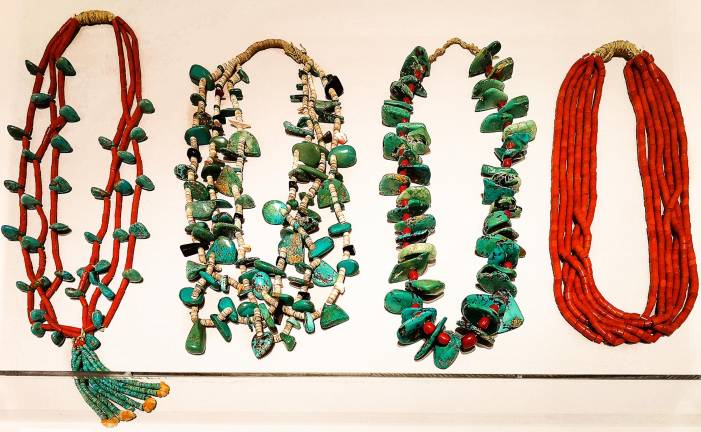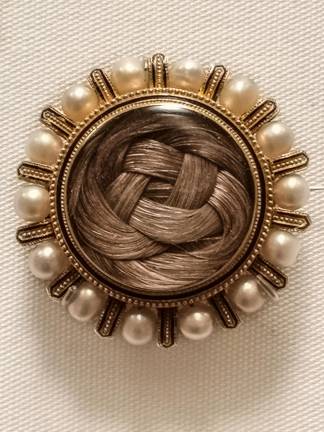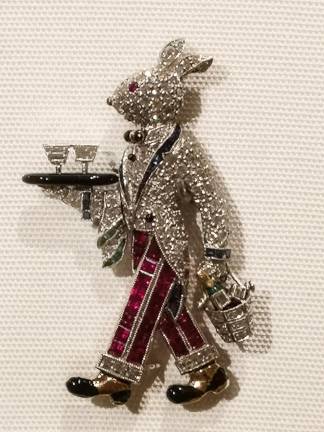American Bling
An exhibit at the Met tracks the evolution of our jewelry, and its role in our lives, from the early 1700s to today




Arranged along a narrow gallery, flanked by portraits of early Americans gazing into the central row of vitrines, are old and new, traditional and modern, glitzy and earthy, commercial and artful examples of how Americans have done bling. Spanning 300 years and laid out chronologically, “Jewelry for America” is a deep dive into gold and silver, diamonds, emeralds, tortoiseshell, and everything in between that's been crafted into personal decorations as jewelry. Men and women alike commemorate milestones – births, marriages, successes, and deaths – with rings, necklaces, brooches, and medals, and they're all on view, in pavé or plastic, from the early 1700s to today.
The pieces, culled from the Met's permanent collection, have been grouped into five sections, each examining a theme or time frame. "Sentimental Journey" addresses how jewelry was used to express desire, mark occasions, or hold dear a loved one. A picture of George Washington made its way onto a gold and enamel "mourning ring" made around 1800, but more touching are the several portrait brooches or cameos that kept the likeness of the beloved (or family, or even just a picture of one eye) pinned right to the heart.
Death, and the Spiritual World
Jewelry made from or encasing human hair may seem odd, but it's long been common to tuck a curl into a locket. A pair of earring from the 1880s, with gold beads giving way to dark, woven drops, looks unspectacular until you read the label and find that the dangles are made of extremely thin braids of human hair. An 1868 Tiffany & Co. brooch carries plaited auburn hair behind a crystal, surrounded by gold and pearls. Only a bit of hair remains of the woman, along with her name engraved on the back, Cornelia Ray Hamilton. Despite date with death it implies, it's elegant and appealing, even to today's eyes.
One of the most moving displays in the exhibition is a case of Zuni beadwork. Necklaces of coral and turquoise from the early 20th century evoke natural and spiritual world views. One can almost feel the energy coming off of them. The collection once belonged to Henry Chee Dodge, a chief of the Navajo Nation, whose photograph hangs above it. The museum does well carrying forward a policy of including Native American art in the galleries and exhibitions in the American wing.
Diamonds, Deco and Bakelite
"American Industry," "Fin de Siècle Brilliance," and "Nature and History as Inspiration" trace changing tastes, including a madness for diamonds spurred by discoveries of mines in South Africa in the second half of the 19th century, and by the rise of luxury manufacturers like Tiffany & Co., Cartier, Dreicer & Co., E. M. Gattle, Verdura, David Webb, and Raymond Yard. Sleek Art Deco styles started to replace traditional forms. One of the most charming pieces, filled with whimsy and sparkle, was designed by Raymond Yard in about 1930. It's a rabbit made of gold, diamonds, rubies and sapphires, carrying a tray of martinis – a declaration of fun and a political statement made right in the middle of the prohibition era.
By the 1930s, American artists like Alexander Calder began to turn their talents toward jewelry. There's a hammered abstract wire coil reminiscent of his greatest sculptural works, along with a stunning silver necklace, at once modern and stylized and referencing timeless Asian, African, and Native American shapes and forms.
The Depression and Post-War periods inspired jewelry makers to adapt, using less costly materials, like plastic. Bakelite's bold colors and shiny surfaces decorated everything from wrists to radios. There's a terrific bright red necklace from an unknown maker from the 1940s that many visitors to the show might covet more than some of the fussy diamonds.
A Glimpse of What We Value
Fluid abstract shapes by Elsa Peretti, an almost conceptual sweep of silver titled "Cello Bracelet" by Ed Wiener, and a surrealist eyeball brooch by Sam Kramer give a hint of how contemporary jewelry makers tackle the complex issues of self-decoration and declarations, ornament, material and design in surprising, engaging, original and exciting ways.
To see glittering gems and precious metals doesn't require a trip to the Met. A jewelry store can provide that, and Fifth Avenue has plenty of the best. It’s the glimpse at what we value, and how we express what we're thinking through what we wear, that makes the Met's "Jewelry for America" shine.